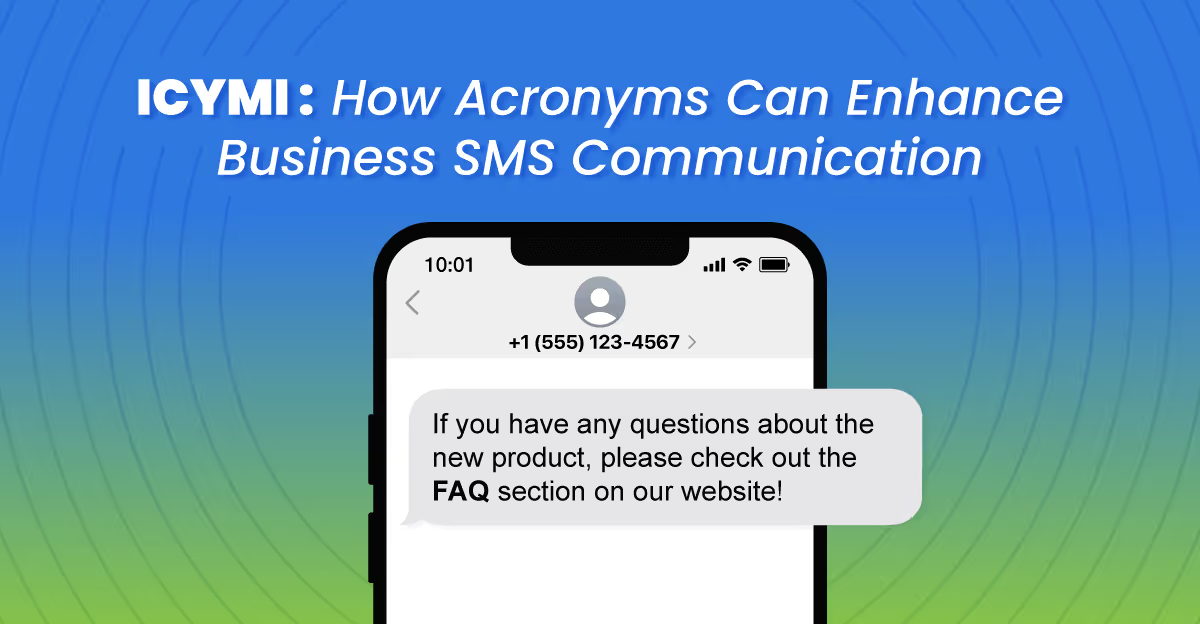ICYMI: How Acronyms Can Enhance Business SMS Communication
Discover how acronyms can save you time, create stronger connections, and improve your business SMS texting strategy.
Published
May 9, 2024

Text messaging has evolved from a simple personal communication tool into a powerful business engagement channel. However, with limited characters, professionals may not be able to say everything they’d like to… or can they?Acronyms are abbreviations formed from the initial letters of words, and they serve as useful shorthand in business SMS messaging. For example, SMS is an acronym for short message service. Everyone says the acronym because no one has the time to say all those words! Like it or not, your customers, coworkers, and other companies are using these abbreviations, so you should, too. This blog will explore the role of acronyms in business texting, some common examples, and how to stay relevant in your business strategies and create stronger connections.
The Role of Acronyms in Business Communication
Business SMS texting offers clients, colleagues, and collaborators a direct line, enabling real-time updates, quick queries, and immediate decisions. In this context, acronyms and text abbreviations serve as valuable time savers. Because of this, learning and understanding common and current acronyms can quicken connections and in turn, make your business successful.Acronyms play a pivotal role in business SMS texting by making the exchange of information more efficient. In a world where time is of the essence, these text abbreviations allow professionals to convey ideas or requests quickly, without the need for lengthy explanations. Using acronyms can significantly enhance productivity, as it frees up time that can be better spent on other tasks.
Examples of Common Business Acronyms
Incorporating acronyms can make your conversations with clients and colleagues feel more personal and relatable. Here’s a look at some commonly used acronyms and examples:
- ASAP (As Soon as Possible): "Please send the report ASAP so we can finalize the presentation."
- ATS (applicant tracking system): "Easily send messages or campaigns from the contact lists in your ATS."
- B2B (Business to Business): "We are primarily a B2B company, but we are looking into expanding into the consumer market."
- B2C (Business to Consumer): "Our B2C sales have been steadily increasing over the past quarter."
- CRM (Customer Relationship Management): “Add two-way texting to your CRM”
- CTA (Call to Action): "Don't forget to include a strong CTA in our marketing emails."
- EOD (End of Day): "I need those figures by EOD Thursday."
- ETA (Estimated Time of Arrival): "What's the ETA on the delivery of our new product?"
- FAQ (Frequently Asked Questions): "If you have any questions about the new product, please check out the FAQ section on our website!"
- FYI (For Your Information): "FYI, the meeting venue has changed to Conference Room B."
- ICYMI (In Case You Missed It): "ICYMI, our big sales event is happening this Saturday!"
- IMO (In My Opinion): "IMO, we should delay the product launch to address these concerns."
- KPI (Key Performance Indicator): "Our team's main KPI for this quarter is to increase sales by 10%."
- OOO (Out Of Office): "I'll be OOO next week. Please direct urgent matters to my assistant."
- ROI (Return on Investment): “SMS messaging can significantly impact a brand’s ROI!”
- SEO (Search Engine Optimization): "Our website's SEO needs to be improved to increase our online visibility."
- TBD (To Be Determined): "The time for the team meeting is still TBD, we will update you as soon as it's confirmed."
Using acronyms saves space and time, making your messages concise and to the point, a necessity for SMS where character count is limited. It's important for businesses to familiarize themselves with a broad range of text abbreviations to refine their engagement strategies.
The Dos and Don'ts of Using Acronyms in Business Texting
When used purposefully and correctly, acronyms can enhance communication with their audience. However, there are a few guidelines to keep in mind when using them:Do use commonly understood acronyms: Using well-known acronyms that are widely used in the industry or workplace can help avoid confusion. For example, everyone knows what "FYI" stands for.Don't overdo it: Using too many acronyms in a single message can make it difficult to understand and may even come across as unprofessional. Use them sparingly, and only when they add value to the conversation.Do provide context: When using an acronym that may not be familiar to all parties, it's essential to provide context or a definition. For example, "We need the Q3 report ASAP (as soon as possible) for our meeting tomorrow."Don't be afraid to ask for clarification: If you receive a text with an unfamiliar acronym, don't hesitate to ask for clarification. This will avoid any misunderstandings and potentially improve your own knowledge of business jargon.
Integrating Acronyms for Business Success
The future of business texting continues to evolve, with acronyms playing a significant role in this transformation. To stay relevant, businesses must stay informed of the latest trends and lingo. Social media and engaging with your audience through platforms where they are active can offer fresh insights into the current verbiage. Modern messaging habits also help businesses appear more relatable and accessible, fostering a sense of familiarity and comfort among customers and colleagues alike.For professionals aiming to harness the full potential of business texting, the time to start integrating acronyms into your SMS strategies is now. Contact us today to learn how TextUs can help you reach your audience ASAP!
Continue Reading
Frequently Asked Questions
Business Texting
Built for Results
Create and convert pipeline at scale through industry leading SMS software




